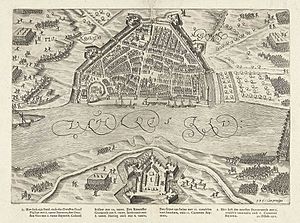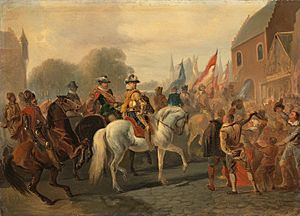Siege of Nijmegen (1591) facts for kids
Quick facts for kids Siege of Nijmegen (1591) |
|||||||
|---|---|---|---|---|---|---|---|
| Part of the Eighty Years' War & the Anglo–Spanish War | |||||||
 The siege of Nijmegen in 1591 – engraving by Pieter Bast |
|||||||
|
|||||||
| Belligerents | |||||||
| Commanders and leaders | |||||||
| Strength | |||||||
| 10,000 | 400 | ||||||
| Casualties and losses | |||||||
| Low | 300 surrendered | ||||||
The Siege of Nijmegen was an important battle during two big wars: the Eighty Years' War and the Anglo-Spanish War. It happened from October 17 to 21, 1591. A combined army of Dutch and English soldiers, led by Maurice of Nassau and Francis Vere, surrounded the city of Nijmegen. The Spanish soldiers defending the city gave up quickly.
Contents
Why Nijmegen Was Important
Nijmegen was a very important city. It was located where the Waal and Rhine rivers meet. This made it a key spot for protecting the Dutch provinces and the area called the Electorate of Cologne.
In August 1589, a group of soldiers tried to attack Nijmegen. They were led by Martin Schenck von Nydeggen. The attack failed, and Schenck, along with about 150 of his men, drowned in the river.
A year after Schenk's failure, the Dutch army, led by Maurice of Nassau, became very successful. They were joined by English troops under Francis Vere. They won many battles. In 1590, they captured Breda. The next year, they took Zutphen, Deventer, Delfzijl, and Hulst.
The Knodsenburg Fort
North of Nijmegen was a strong fort called Knodsenburg. The Dutch had built it, and it had a great view of the city. In July, Alexander Farnese, the Duke of Parma, brought more Spanish soldiers to Nijmegen. He then tried to capture the Knodsenburg fort. He wanted to stop the Dutch and English from attacking the city.
However, Maurice's forces defeated Parma and made him retreat just ten days later. Soon after, Parma was sent by Philip II of Spain to France. He had to fight in the Huguenot war against Henry IV of France. This left Nijmegen much weaker. Maurice and the Anglo-Dutch army decided to attack the city that autumn.
The Siege Begins
On October 16, Maurice and his army built a bridge over the Waal river. This river was deep, wide, and fast. They moved 8,500 foot soldiers and sixteen groups of cavalry to the south side of the city. The next day, they completely surrounded Nijmegen.
Maurice's army included 26 English and Scottish companies led by Francis Vere. There were also Frisian soldiers led by William Louis, who was Maurice's nephew. Inside Nijmegen, there were fewer than 400 Spanish soldiers. They were commanded by the city's leader, Derrick Vlemminck.
Bombarding the City
Maurice had made the fort at Knodsenburg even stronger. This allowed him to fire cannons at the city from there. But the city would not surrender. So, Maurice knew he needed to get closer to the city walls.
The English and Scottish soldiers, led by Francis Vere, attacked the areas outside the city. They captured all the small forts, called sconces. The Anglo-Dutch army then dug in and moved closer to the city. This was easier because the Waal river's water level was low.
They set up 68 cannons in three different spots. These cannons aimed at the weakest part of the city's defenses. This area was between two places known as the Falcon Tower and the Hoender Gate. The cannons at Knodsenburg were on a high spot. They fired heavily on the city from across the river. The tall spire of St. Stephen's Church was destroyed by the shelling. Many other buildings in the city were also ruined.
On October 20, Maurice demanded that the city surrender. But his demand was refused. The attackers then started firing all their cannons without stopping.
Within a few days, the people in the city decided to talk with Maurice about surrendering. This happened because the city's leaders, called burghers, disagreed with the Spanish soldiers.
After the Battle

The city had some conditions for surrendering. But Maurice did not accept them, except for a full pardon for the people. This was finally agreed upon. About 300 Spanish soldiers surrendered and were given the honors of war. The terms of their surrender were similar to those given to Zutphen and Deventer.
Maurice also replaced the Catholic leaders in the city with Protestant ones. The practice of the Catholic faith was no longer allowed in Nijmegen. To show his intentions, the Grote Markt (main market square) was burned on May 21, 1592. It had many Catholic images.
Another important city was now part of the Dutch Republic. Queen Elizabeth I wrote to Maurice to congratulate him on his great successes. Even the Spanish began to see how skilled he was. Maurice kept attacking. The next year, he had an amazing campaign. He captured Steenwijk in July. He did not stop until Groningen was captured in 1594. By then, the entire Drenthe region had been taken over.

